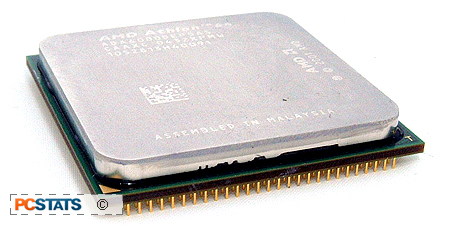AMD Athlon 64 4000+ socket 939 Processor Review
On October the 19th, AMD
officially launched the latest version of its successful Athlon 64 processor
line, the 2.4GHz Athlon 64 4000+. PCstats spent a few weeks with this CPU prior
to its release, and after running the silicon through its paces, we've come to a
couple conclusions which we'll share with you in this review.
As you're
undoubtedly already aware, the AMD Athlon 64 4000+ is the third Athlon 64 processor to be released
for AMD's new socket 939 platform, following up on the successes of the Athlon64
3500+ and 3800+. These Athlon 64 processors share the socket 939 form factor with
the high end Athlon 64 FX class, though as you will see later in this review,
the line between the two is beginning to blur.
Interestingly, the Athlon 64 4000+ is
not clocked faster than its nearest predecessor (the Athlon64
3800+, also 2.4GHz) as you might expect, but that doesn't preclude it from
obtaining a healthy boost
in the benchmarks. Rather than a little bump up to 2.6GHz, the Athlon64 4000+
has had the benefit of some internal core changes to boost its performance. To
be specific, the Athlon 64 4000+ contains twice as much Level 2 Cache memory of
the Athlon64 3800+. In other words, this chip is packing a full 1MB of exclusive
L2.
 |
|
|
AMD Athlon64 4000+ Processor |
|
|
 |
| Tech
Specs |
|
Clock: 2.4GHz
L1: 124KB
L2:
1MB
Multipiler: 12x
Package: 939-pin
organic
mPGA
Core: 130nm SOI
Transistors: 105.9M
Die Size:
193mm2
Vcore: 1.5V
Thermal
Power: 89W
Cost: $729USD
| |
|
Further Technical Details:
CPU-to-Memory Controller: 2.40GHz
Memory: Integrated
128-bit wide memory controller
Types of Memory: PC1600, PC2100,
PC2700 and PC3200 DDR
HyperTransport Links: 1
HyperTransport Spec: 2GHz (2x 1000MHz / DDR)
Effective data bandwidth: Up to 14.4
GB/sec (8GB/sec
HyperTransport bandwidth plus 6.4GB/sec
memory bandwidth)
Fab location: AMD's Fab 30 wafer in Dresden,
Germany
Ambient Case Temp: 70 degrees Celsius
Max Icc (processor
current): 57.4A | |
A 64-bit & 32-bit CPU
When originally introduced in
the summer of 2003, the AMD Athlon 64 processor line signaled the emergence of a
new breed of
desktop 64-bit/32-bit capable
processors. The Athlon 64's architecture allowed it to operate as a 32-bit processor, or
as a 64-bit processor when future versions of Windows XP-64-bit were to become
available.
The modes as they were called,
included 'Legacy mode' which was for 32-bit x86 software, and 'Long Mode' which
is made up of two sub modes; 'Compatibility Mode' and '64-bit Mode.'
The Compatibility mode is
designed for a 64-bit operating system such as Microsoft's impending 'x64
edition' of Windows XP and Microsoft Server 2003 running 32-bit software. 64-bit
mode is intended for a pure 64-bit environment, both operating system and
software. 
These modes of operation allow
the AMD Athlon 64 processor to remain compatible with conventional 32-bit
operating systems and applications, while at the same time allowing software
manufacturers a solid 64-bit platform on which to design the applications and
operating systems of the future. PCstats has recently conducted a few head on
comparisons between these 32-bit and
64-bit modes, which illustrate the performance potential of the Athlon64 quite
nicely.
In its short history, the AMD
Athlon 64 processor has already gone through a few design changes. Starting with
the 754-pin package, AMD has migrated the latest versions of this
processor to a 939-pin package. The Athlon64 4000+ continues to share this
socket 939 form factor with its newest 64-bit cousin, the 2.6GHz Athlon FX-55.
Though in the past you could
differentiate the Athlon 64 from FX processors by the way their memory
controller operated (single channel for the Athlon 64, dual-channel for the
high-end Athlon FX line), the current socket 939 models of both processors use
dual channel memory controllers. The two processor types also differed in the
past by the amount of Level 2 Cache memory they came equipped with. Older Athlon
FX models had double the Level 2 Cache memory of their more affordable Athlon 64
siblings. This trend has also apparently come to an end, as now both the Athlon
64 4000+ and the Athlon FX-55 sport a full 1MB of Level 2 Cache memory.
Presumably this is to help AMD streamline their manufacturing process.

